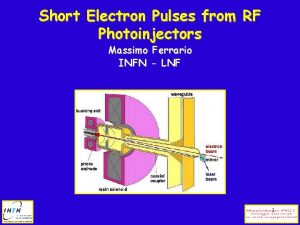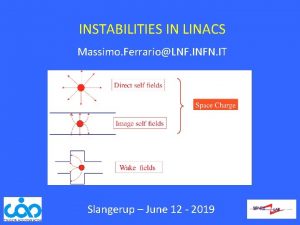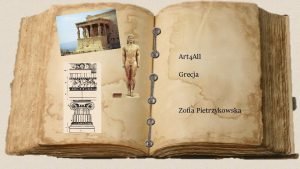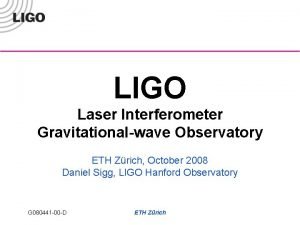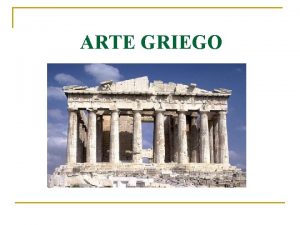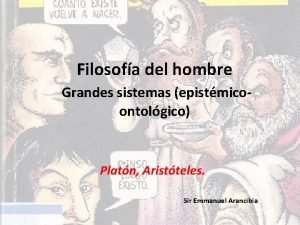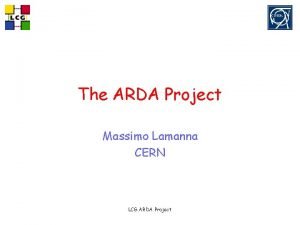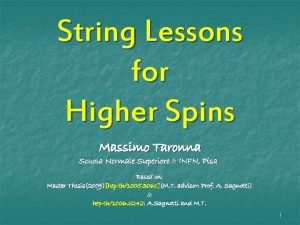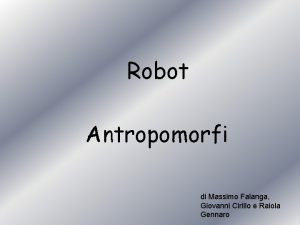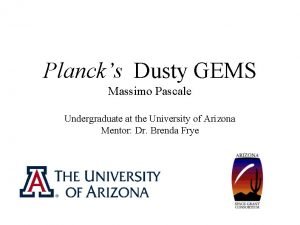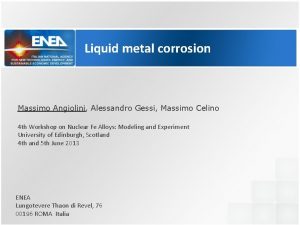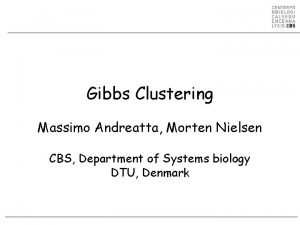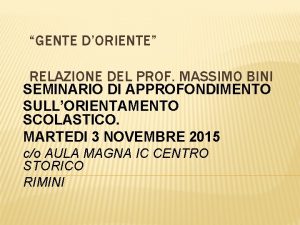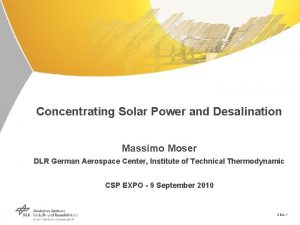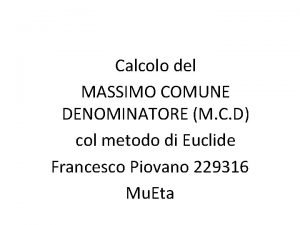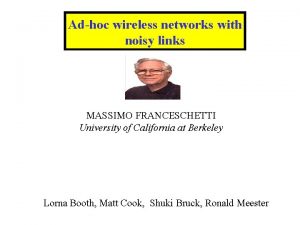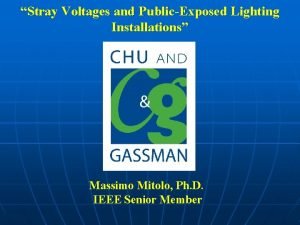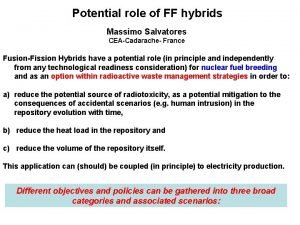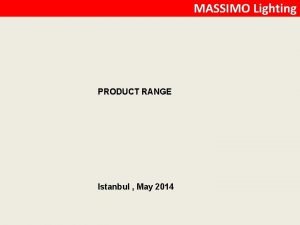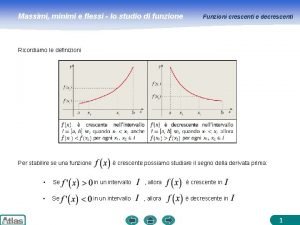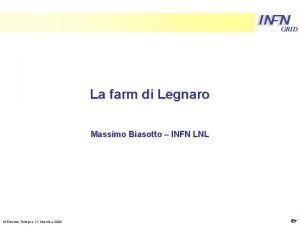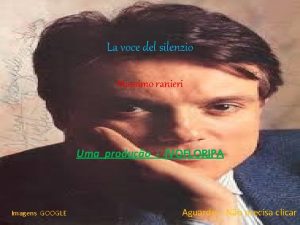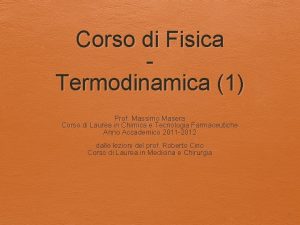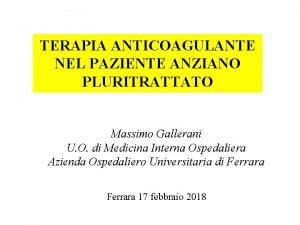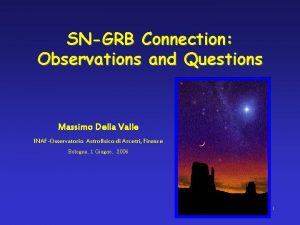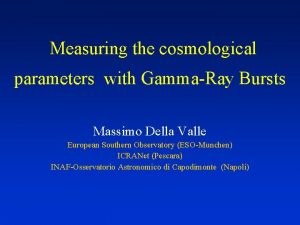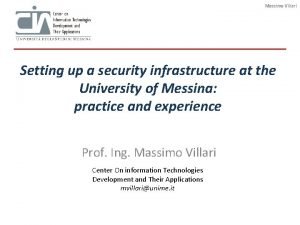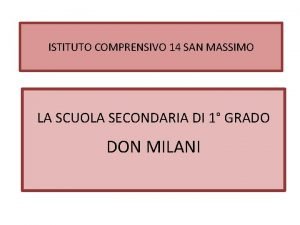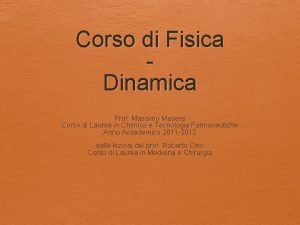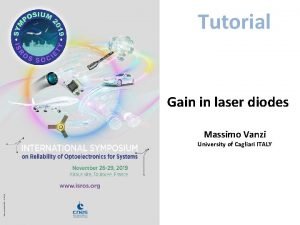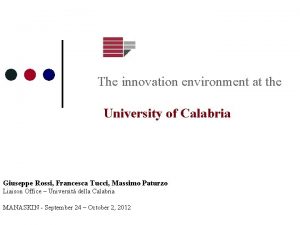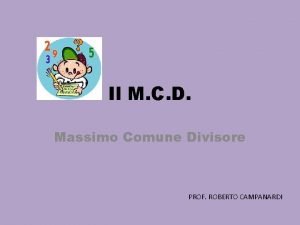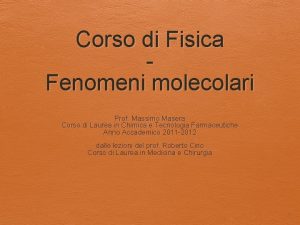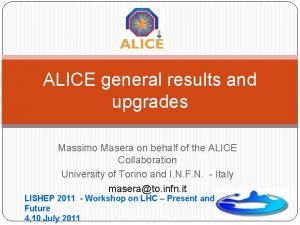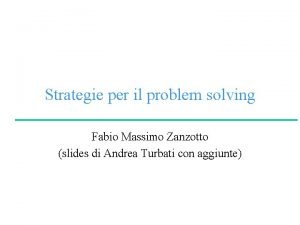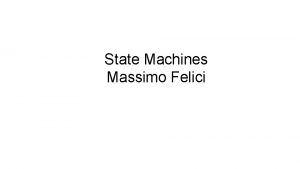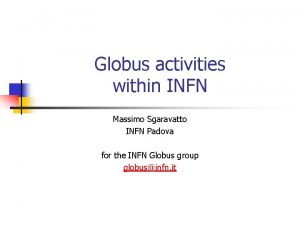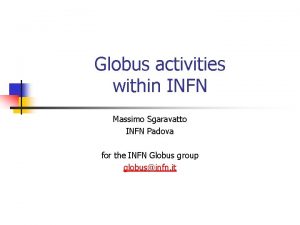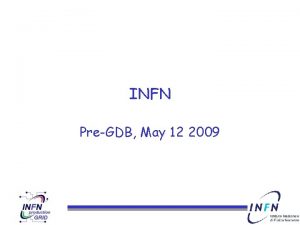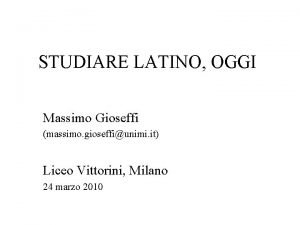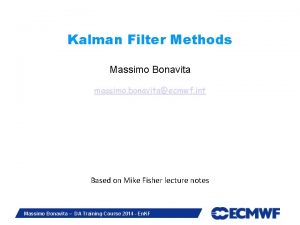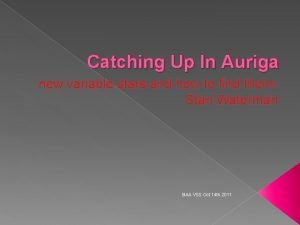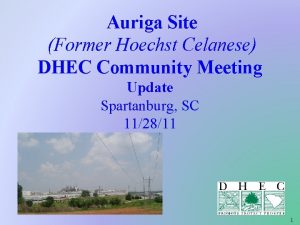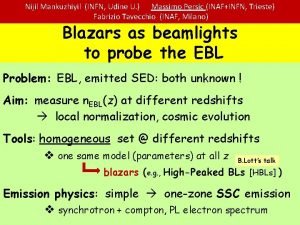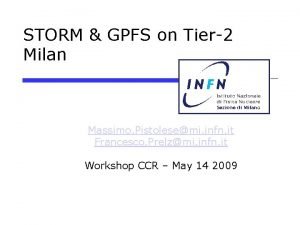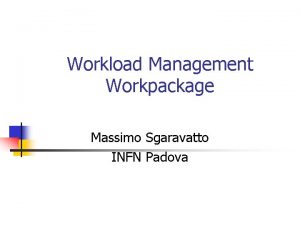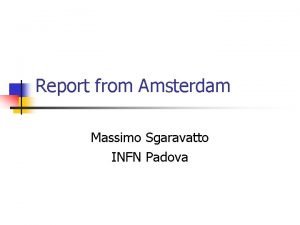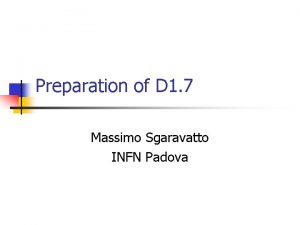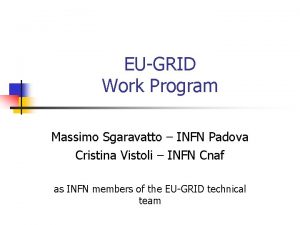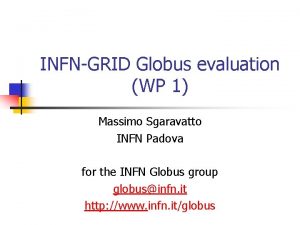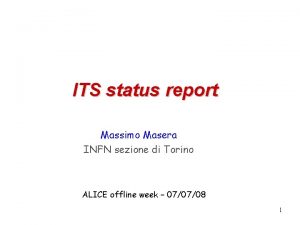AURIGA Massimo Cerdonio INFN Section and Department of













































- Slides: 45

AURIGA Massimo Cerdonio INFN Section and Department of Physics University of Padova, Italy AURIGA www. auriga. lnl. infn. it Comm. II@Roma Oct 6 th 2005

bar gw detectors (brief reminder) • SQL, antenna pattern, timing resolution, detection efficiency, bandwidth AURIGA recent upgrades and performance • three modes + approach the SQL (Standard Quantum Limit) to widen the band • suspensions and seismic insulation AURIGA current astrophysical observations • AURIGA and the Dec 27 th 04 giant flare in SGR 1806 -20 • IGEC-2 • AURIGA-ifos (GEO, LIGO, VIRGO, TAMA) ultracryogenic AURIGA • T ~ 100 m. K, Ebias ~ 2 107 V/m, SQUID < 30 quanta

“bar” gw detectors L/L ~ hgw M = 2. 3 t L = 3 m

“bars” at the Standard Quantum Limit detect few quanta in a 2. 3 tons oscillator need: k. BT/Q < h. Planck f • wide detection bandwidth f~100 Hz, large Q/T ~ 108 K-1 T~ 0. 1 K, Q ~ 107 • a quantum limited amplifier: SQUID, optical, … where are we ? f~100 Hz Q ~ 5 106 AURIGA @ 4. 5 K AURIGA @ 0. 1 K E ~ 500 quanta E ~ 10 quanta h. SQL ~ 3 10 -21

SQUID energy resolution vs year — in the detector ● coupled to a LC resonator AURIGA 0. 1 K two stage LHe T Detector Teff 4 Tn ultracryogenic

sen 2 cos 2

• Measurement of detection efficiency by Monte Carlo injections of software signals • crucial to cross-validate detectors in a network detection efficiency for signals arrival time estimation for signals • Submillisecond arrival time resolution • crucial to check travel speed of the gw and to locate the source

the bandwidth is potentially infinite

AURIGA run II: upgrades v three resonant modes operation: two mechanical modes one electrical mode v transducer bias field 8 MV/m v new SQUID amplifier : double stage SQUID ~500 energy resolution at 4. 5 K in the detector

Shh sensitivity (2) one-sided Shh Very good agreement with noise predictions all these noise sources will scale with temperature

May 19 th 2005 AURIGA on the dampers

LF suspensions upgrade: on-line effect (May 19 th) Sensitive frequency band suspension activation 1 hour

the three modes of AURIGA as they keep clean and stable in time

P. Falferi et al, “ 3 -modes detection…” Phys. Rev. Letters 2005 M. Bonaldi et al, “AURIGA suspensions…” Rev. Sci. Instr. 2005 A. Vinante et al, “Thermal noise in a…” Rev. Sci. Instr. 2005


AURIGA II run stationary gaussian operation of a wideband “bar” detector the 3 modes thermal at 4. 5 K Shh 1/2 < 4 10 -21 Hz-1/2 over 90 Hz band (one sided) ~ 100% operation for acquisition of usable data (except 3 hours/month > He transfer) veto time intervals under out-of-band triggers to select against epochs of external disturbances reduce (for bursts) to stationary gaussian operation over ~ 98 % duty cycle

AURIGA with an optomechanical transducer already worked as room T detector will start operation at low T in 2006 bench test to study thermoelastic effects and thermal noise in mirrors (substrates and coatings)

Towards a cryogenic bar detector with optical readout Bar and transducer assembly. The cryostat: bar Predicted gw sensitivity at T=4 K Transducer Q vs T The reference cavity

current astrophysical observations AURIGA alone: upper limits related to astronomical triggers giant flare of SGR 1806 -20 L. Baggio et al. , PRL 95, 081103 (2005) search for quasi-periodic gw from NS in binary systems (LMXB) AURIGA in network: IGEC-2 network of the 4 operating resonant bars • search for bursts gw, long term observations AURIGA-LIGO • burst gw search (methodological phase) VIRGO & INFN bars network • burst and stochastic background search (methodological phase) AURIGA-TAMA (just started)

the “bar” network: Int. Gravit. Event Collaboration very encouraging: 3 -4 detectors IGEC-2 in coincidence most of the time Dec 04 onward (much more than IGEC-1) LIGO S 2, S 3 & S 4 will improve considerably IGEC-2 will be comparable LIGO S 5 will overcome

2 Shh of resonant bar detectors current IGEC-2 Shh lower bound cooling to T=0. 1 K same Q * Conservative estimate

2 • amplitude of exchanged candidate events (Dec 2004) • AURIGA is the most sensitive detector The AURIGA background is remarkably low at the sensitivity of the other detectors Event counts EXPLORER NAUTILUS AURIGA Event amplitude H [Hz]

The Dec. 27 th 2004 giant flare of the soft gamma ray repeater SGR 1806 -20 • on a ~ 10 kpc distance scale in the direction of Sagittarium • 100 times more energetic than any other • after peaking with ms rise time, decayed to 1/10 intensity in ~ 300 ms a catastrophic instability involving global crustal failure in a “magnetar”, which possibly triggers the excitation of f- and p-modes in the neutron star the excited mode damps out by gw emission, the energetics of which would be ~ 100 times larger of that of the X-rays flare

AURIGA and the flare • was optimally oriented towards 1806 -20 at the flare time • was performing as a stationary gaussian detector • was covering a ~ 100 Hz band in which neutron star f- and p-modes may fall we test if, at the flare time, gw emission is found, as a damped sinusoidal wave train at any frequency f within AURIGA band, with damping time s • divide the band in sub-bands of width f~1/ s around each f • integrate for a time t~ s the output energy • check the statistics of the time series • test for any excess in the sub-band (t) in each sub-band f (t) at the flare peak time tp we take s = 100 ms as ~ 1/3 of the observed flare decay

AURIGA gaussianity -100 s to +100 s around flare time

Baggio et al. (AURIGA collaboration) Phys. Rev. Letters 95 081103 (2005) the Dec 27 2004 giant flare from SGR 1806 -20 95%confidence upper limits: theory (magnetar “big one” ): gw < 5 10 -6 MOc 2 (best…) gw ~ 5 10 -6 MOc 2

upper limits on emitted gw energy as fraction of solar mass Over the sub-band at frequency f of width f models predict gw ~ 5 10 -6

comments on AURIGA & the flare • stationary operation allows relevant searches even with a single detector • obtained an upper limit about neutron stars dynamics, which is relevant as it invades part of the parameter region of existing models • stronger upper limits could be put with optimal search methods ( I did not discuss this point > see PRL paper)

World-wide gravitational wave network GWIC http: //gwic. gravity. psu. edu/ is helping with steps toward a world-wide network including the large interferometers and (more recently) bars. So far, bi-lateral exchanges – GEO - LIGO continuing exchange & joint papers – LIGO- TAMA exchange data for S 2 data (60 days Spring 03). Small joint working group to coordinate the joint analysis – Virgo and LIGO exchanging environmental data, and Virgo preparing for future gravitational data exchange – AURIGA- LIGO exchanged 15 days of S 3 data and are tuning tools – AURIGA+EXPLORER+NAUTILUS+VIRGO are developing methods for joint analysis of bursts and stochastic – EXPLORER+NAUTILUS and TAMA exchange data – AURIGA and TAMA are preparing for data exchange


operation of AURIGA at ultracryogenic temperatures • 2005: – realization of the new 1 K pot stage (design completed) – modification and supports of the dilution unit – conclude R&D on SQUID and LC resonator (electrical Q) • 2006: – test of the new 1 K pot stage – realization of the ultracryogenic thermal link to the bar – realization of the ultracryogenic thermal shields – modifications of the He lines at room temperature – optimization of selected components of the transducer system


• AURIGA detector plan 2005 -2007 (and beyond…) 2005 -6: – continuous science run of AURIGA at LHe temperatures – preparation of the upgrade for ultracryogenic operation • 2007: – detector upgrade – science run at 0. 1 K contribute to the upcoming global network of current generation interferometric detectors for gw signals in the bandwidth – reduce false alarms in the network – locate gw source by high resolution timing - allow tests on Riemann properties of signal

Preventivo di Spesa 2006 Globale 447 k€ (308 assegnato nel 2005) Riepilogo Globale per Capitoli MI 74 k€ ME 50 k€ Cons 155 k€ Aff e man 10 k€ Inv. 70 k€ Costr. app. 67 k€ Riepilogo per Sezioni Pd 184 Tn 137 LNL 111 Fe 14 Fi 21 Riepilogo per attivita` principali: Rivelatore ed analisi dati AURIGA ultracryo Sviluppo sistemi di trasduzione Front-end acquisizione 230 k€ 100 k€ 40 k€ 23 k€


Milestones 2006 • 31− 12− 2006 1 anno di presa dati con sensibilita' impulsiva di circa 0. 3 m. K, banda passante dell'ordine di 50 Hz e ricerca di ondeimpulsive con osservazioni congiunte con gli altri rivelatori operativi risonanti e interferometrici. • 31− 06− 2006 Funzionamento alle temperature criogeniche della catena di trasduzione ottica integrata su una barra identica a quella di Auriga. • 31− 07− 2006 Riduzione delle dissipazioni in sistemi risonatore elettrico − SQUID operanti a temperature ultracriogeniche con risoluzioni in energia migliori di 30 hbar. • 31− 12− 2006 Realizzazione della componentistica per rendere ultracriogenica AURIGA

P. Falferi et al, “ 3 -modes detection…” Phys. Rev. Letters 2005 M. Bonaldi et al, “AURIGA suspensions…” Rev. Sci. Instr. 2005 A. Vinante et al, “Thermal noise in a…” Rev. Sci. Instr. 2005 red: exp blue: sim ~ 4 days of continuous operation duty cycle ~ 98% SNR date

certezze gw exist: binary pulsar dynamics agrees to highest known post-Newtonian order with Einstein GR the 10 Hz - 1 k. Hz gw band “chirps” of inspiraling ns-ns and bh-bh binaries physics: dynamics of “point” masses in full GR the f > 1 k. Hz band physics: gravity overwhelms fundamental interactions neutron stars: hot newborn after Sn, merger after coalescence of binaries, vibrations, rotational instabilities, shock waves in the neutron fluid, crust cracking (role of Equation Of State) black-holes: merger, vibrations (study extreme gravity)

gw the only direct probe of dynamics f ~ 10 Hz - 1 k. Hz: detect phase coherent “chirps” lasting ~ 103 s unfolding on the whole band >>> “interferometers” the best f > 1 k. Hz: extract short “bursts” from noise to detect fine time structure details >>> “bars” the best (in “tune”…) f > 1 k. Hz need: • stationary “gaussian” (few spuria/day) wideband detector AURIGA >>> 100 Hz band, 99%duty cycle, few spuria/day • Shh(f) ~ 10 -23 Hz -1/2 over f ~ 1 -5 k. Hz DUAL the 5 k. Hz wideband detector

The AURIGA readout: scheme Bar Matching transformer Two-stage SQUID Intrinsic Q line Shielded resonant transducer Bias field line Calibration line Feedback electronics

Mechanical response to a force on the bar • Experimental transfer function. Force applied by a capacitive force actuator (the “calibrator”) mounted on the opposite face of the bar. • Spurious modes present, but not considered in the fit.

Checking thermal noise of modes (2) 2) Measure the “intrinsic” Q by decay time. Need to disable cold damping and completely inhibit sensor SQUID to avoid dynamical damping effects. Mweak Mstrong Intrinsic Q line SQUID 2 as amplifier Ibias>>Icrit SQUID 1 disabled 3) Example of continuous monitoring: mode 2 (914 Hz) noise for 2 weeks

Checking thermal noise of modes (1) The expected thermal noise of a resonant mode (referred to SQUID input): Cold Damping correction To measure equivalent temperature Teq need to measure, besides noise SII: ZCD (the impedance from SQUID port) Q (the “intrinsic” dissipation without cold damping, which generates thermal noise) 1) Measure the impedance ZCD of the circuit seen from the SQUID port: Iin Ical Calibration line Mcal

AURIGA-LIGO S 3 run: Oct 31 2003 – Jan 9 2004 AURIGA run 331: Dec 24 2003 – Jan 14 2004 Intersection: AU-H 1 -H 2 -L 1 AU-H 1 -H 2 36 hr 108 hr The threshold tuning procedure is still in progress! Preliminary A bar with Shh minima not far from the interferometer Shh can contribute to the network

 Massimo ferrario infn
Massimo ferrario infn Chao chao slangerup
Chao chao slangerup Szalejąca menada
Szalejąca menada Auriga suhvezdie
Auriga suhvezdie Auriga 30w laser
Auriga 30w laser El arte griego
El arte griego El mito de la auriga
El mito de la auriga Massimo lamanna
Massimo lamanna Massimo taronna
Massimo taronna Massimo falanga
Massimo falanga Massimo pascale
Massimo pascale Silvia bandinu
Silvia bandinu Massimo angiolini
Massimo angiolini What are 3 domains
What are 3 domains Massimo bini
Massimo bini Riduzione al minimo comune denominatore
Riduzione al minimo comune denominatore Massimo strino kaleidoscopes
Massimo strino kaleidoscopes Massimo moser
Massimo moser Massimo comune denominatore
Massimo comune denominatore Massimo franceschetti
Massimo franceschetti Massimo mitolo
Massimo mitolo Massimo salvatores
Massimo salvatores Massimo mellacina
Massimo mellacina Massimo lighting
Massimo lighting Minimi massimi e flessi
Minimi massimi e flessi Massimo biasotto
Massimo biasotto Massimo ranieri silenzio
Massimo ranieri silenzio Erotikchats
Erotikchats Massimo masera
Massimo masera Guadagno meccanico leve
Guadagno meccanico leve Massimo paone
Massimo paone Massimo gallerani età
Massimo gallerani età Massimo della gamma
Massimo della gamma Massimo della gamma
Massimo della gamma Massimo villari
Massimo villari Istituto comprensivo san massimo
Istituto comprensivo san massimo Massimo mariano psicologo
Massimo mariano psicologo Massimo masera
Massimo masera Massimo vanzi
Massimo vanzi Massimo paturzo
Massimo paturzo Massimo ciocca
Massimo ciocca Massimo comune divisore
Massimo comune divisore Massimo masera
Massimo masera Massimo masera
Massimo masera Zanzotto tor vergata
Zanzotto tor vergata Massimo felici
Massimo felici
